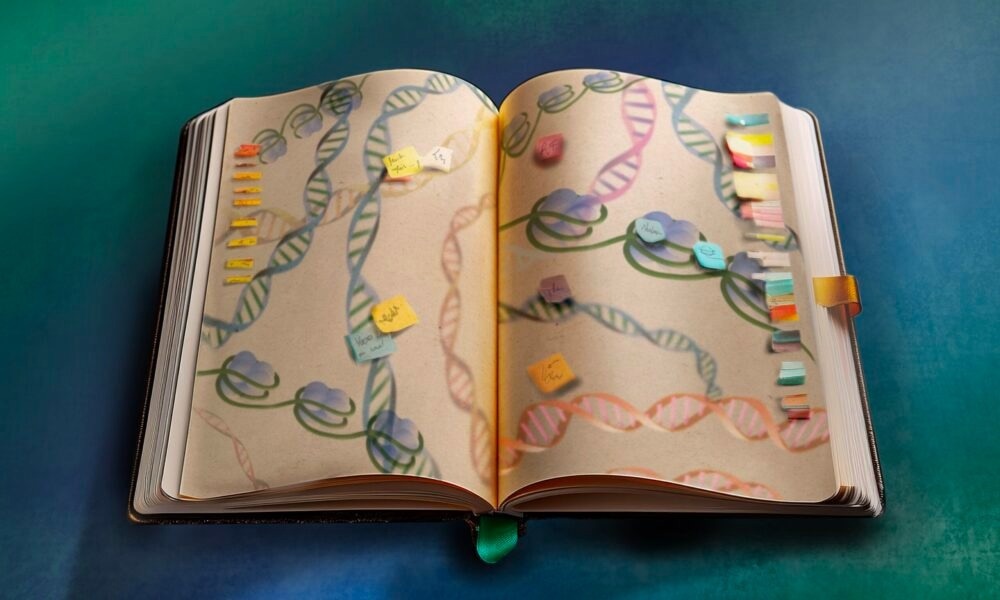Reviewed by Danielle Ellis, B.Sc.Sep 19 2024
For any organism to survive and thrive, its cells must tightly control which genes are activated, when, and where. New research from EMBL Heidelberg’s Noh Group and collaborators from EMBL Australia sheds light on some of the key control sites that regulate this process, particularly the activity of ancient viral sequences within the genome.
 Epigenetic marks are like notes and highlights on the tome that is our genome. New research shows a causal role of histone modifications in gene regulation. Image Credit: Isabel Romero Calvo/EMBL, image generated with support of Adobe Firefly AI
Epigenetic marks are like notes and highlights on the tome that is our genome. New research shows a causal role of histone modifications in gene regulation. Image Credit: Isabel Romero Calvo/EMBL, image generated with support of Adobe Firefly AI
Human genomes are enormous; one human cell’s worth of DNA has more than 6 billion information units (called “base pairs”). Thanks to this informational gold mine, though, finding the appropriate information at the right moment to complete a task can be difficult. Epigenetic signatures are relevant in this situation.
If one were to picture the genome as a book, epigenetic marks would be the annotations in the margins and the highlights on the pages. Now, it is not always clear if these markings are “instructive” in the sense that they advise the cell to read something or not. Or are they just traces left by someone who has read the book before, letting everyone know that section has been read before?
This was the question that intrigued Kyung-Min Noh, Group Leader at EMBL Heidelberg, and her team. The researchers chose to focus on H3.3, a protein from the histone family. Histones bind tightly to DNA in cells and contribute to its functional structure.
The H3.3 protein has two spots on its tail (K9 and K27) that are frequently chemically modified. These changes are hypothesized to be epigenetic marks that assist the cell in making gene expression decisions. However, until now, it has never been experimentally proven that these are genuine control sites that direct gene expression.
The researchers decided to experimentally mutate these sites, resulting in a version of H3.3 that could not be chemically altered at these locations. Using the book analogy above, this resulted in a protected page that could not be highlighted or marked, allowing scientists to investigate the consequences of losing such marks directly.
Furthermore, this system allowed the researchers to change which page was protected, allowing them to compare the loss of modifications at one versus the other control sites.
The scientists discovered that mutations at these sites in mouse stem cells caused not only defects in cell differentiation, growth, and survival but also spurious activation of genes throughout the genome. This included genes that should not be expressed in stem cells, like immune system-specific genes.
This suggested that the normal function of these sites is to keep those genes inactive - or repressed - allowing stem cells to remain stem cells. These effects were also different between the two control sites studied, indicating that each has a unique role in gene regulation.
Following further investigation, the researchers discovered that some of these regions, which are normally repressed but became active when the histone sites were mutated, are ancient remnants of viruses that had integrated into our genomes.
These regions are also called endogenous retroviruses (ERVs). Throughout evolution, they have been co-opted by the host’s genome to exert regulatory functions. In immune cells, for example, 30% of the enhancers (a specific type of regulatory DNA element) are derived from ERVs.”
Matteo Trovato, Study First Author and Postdoctoral Researcher, IFOM
The researchers discovered that by modifying the K9 site in stem cells, many 'cryptic' enhancers - regulatory DNA regions that are normally silenced - were activated.
Repression of these unique genomic regions is crucial for preserving the cell’s gene expression program balance. Activation of the cryptic enhancers triggers a widespread rewiring of the gene regulatory network, ultimately impacting stem cell identity and functionality.”
Kyung-Min Noh, Group Leader, EMBL Heidelberg
The research was conducted in collaboration with Chen Davidovich's group at EMBL Australia, Benjamin Garcia's lab at Washington University in St. Louis, and Judith Zaugg's group at EMBL Heidelberg. The findings were recently published in the journal Nature Communications.
Noh concluded, “This is one of the first few studies conducted in a mammalian system showing that these histone residues play a causal role in gene regulation. Understanding this process could have broader implications for developmental biology and disease research, particularly in cancer and neurological disorders, where gene regulation plays an essential role.”
Source:
Journal reference:
Trovato, M., et. al. (2024) Histone H3.3 lysine 9 and 27 control repressive chromatin at cryptic enhancers and bivalent promoters. Nature Communications. doi.org/10.1038/s41467-024-51785-w